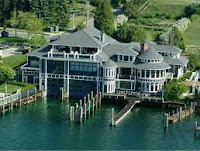August 30, 2011 Dateline: Port Washington, WI USA
As I pulled out of Sheboygan this morning at 8:30 AM (Rich and Carol are getting lazy in their old age.) I was hailed by Passport who was about a mile away. Her owners recognized my gorgeous shape and asked where I was going. They were going to Port Washington as well so we agreed to get together later in the day. I had meet Passport in Frankfort, Michigan when we both were stuck for three days due to the strong winds on the lake. They went to Sturgeon Bay, Wisconsin with Oddysea when I went to Manistee, Michigan. I arrived in Port Washington about 11:30 and Passport came in about 15 minutes later.
Port Washington is the oldest man made harbor in North America and has the largest concentration of pre-Civil War buildings in Wisconsin.
The Wisconsin Chair Company operated in the city from 1888 to 1954 and was its largest employer and employed one sixth of the people in the county. The city also had a large fishing industry. The Smith Brothers operated a fishing business in the city, as the fishing died off ,they then opened a restaurant that only closed a few years ago.
The Michael Bink building was built in 1891. The buildings first floor was originally a saloon and then became a funeral home. If it was a funeral home during Prohibition, I would guess that people were dying to get a drink in the old saloon.
The Hoffman House Hotel was built in 1895. It was billed as a “first class” hotel in every respect. The building even had an “automobile terminal” on the side.
The Edward Dodge home was built in 1848 and is made out of beach stones. A blacksmith by trade Smith and his wife gathered colored stones from the Lake and used them to make the colored bands that form the buildings walls.
Rich found this sign interesting, is it a warning to criminals or is to let citizens know they’re always open for business? Something to ponder!!!
These stairs lead to a church at the top of the hill. After climbing the stairs I wonder how many church goers stay awake during the service.
Tomorrow it’s off to Milwaukee, WI


